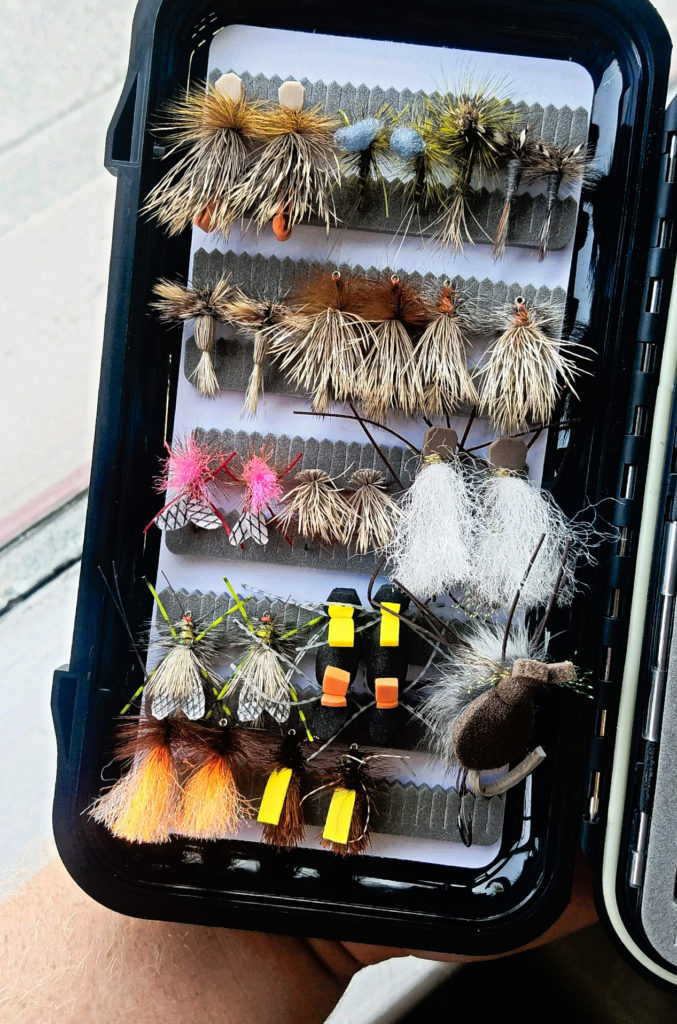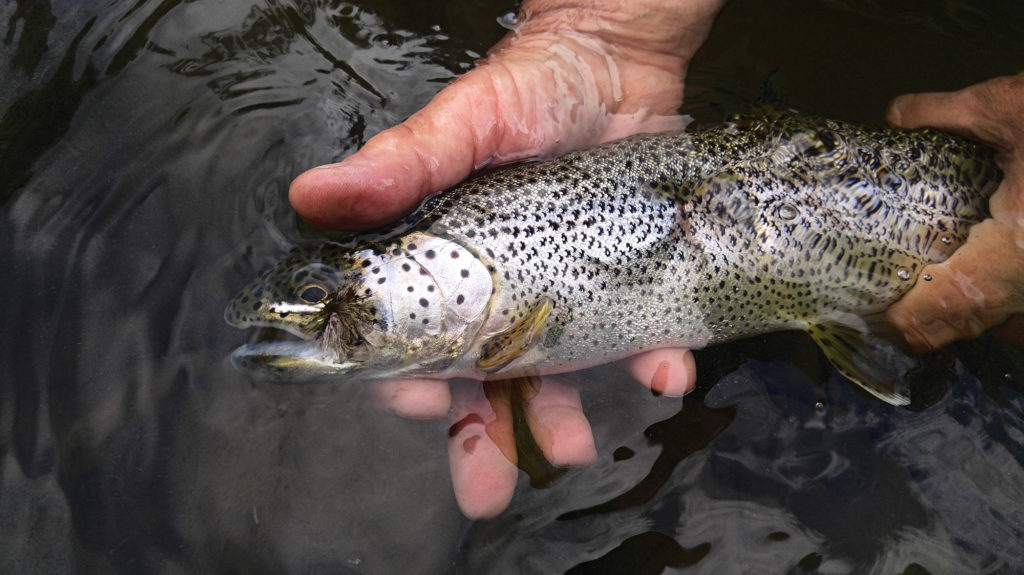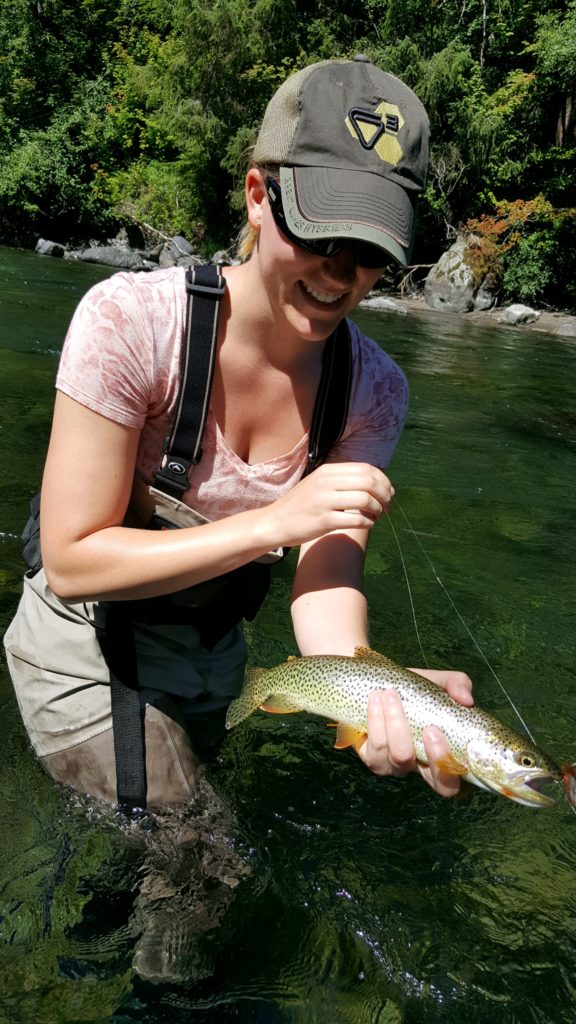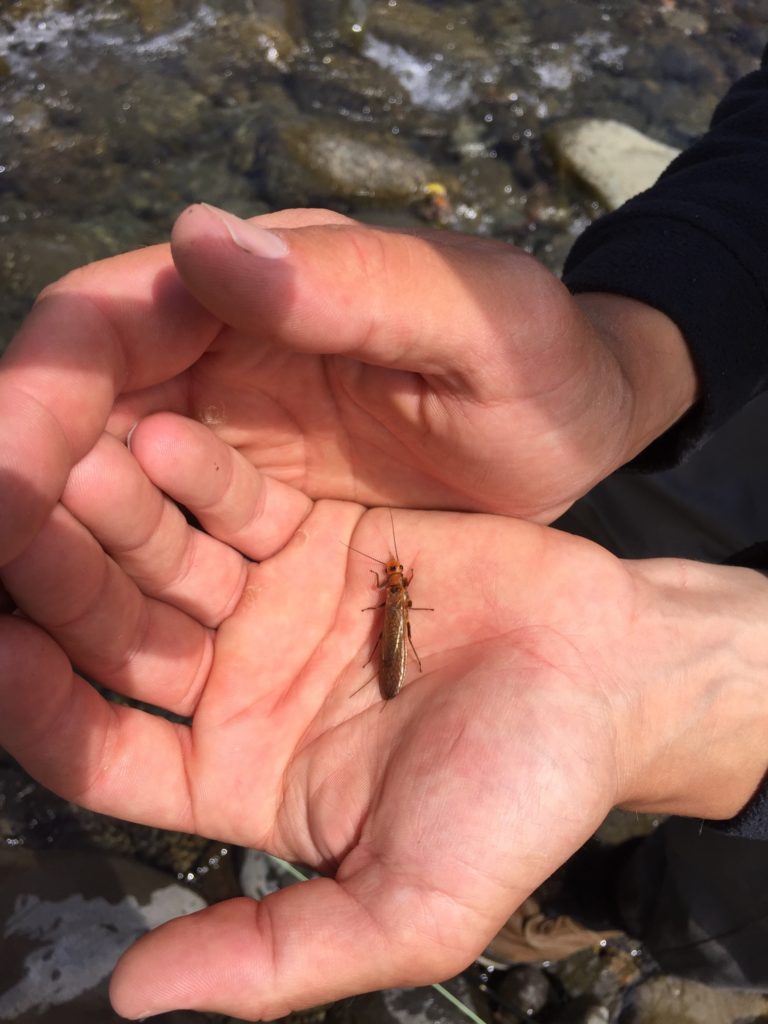
Big dries for Olympic Peninsula trout

A Cutthroat more than happy to take this Cellophane Wing Green Drake Pattern
We fish them big and we fish them fast. On the Olympic Peninsula you may find our Cutties ready to take what ever is properly presented, though at times they may seem finicky, our fish are highly opportunistic. Nymphs, small dry’s-big dry’s, small soft hackles – big 3.5 inch rabbit strip streamers, our Cutties will eat them. Of all these flies there is one that is held most high, and that’s the dry fly.
Its not that we are purest dry fly enthusiasts (though admittedly most of us secretly are) its that OP trout crush the largest surface patterns with surprising enthusiasm. Often the bigger the better. On the Olympic Peninsula our Cutthroat trout break the norm, having a short feeding period they are highly aggressive and are looking for any opportunity to feed.

Morrish Caddis. A foam bodied October Caddis fly. Bottom right hand side in the Cutthroats mouth
Side Note: Steelhead smolt, (juvenile steelhead living in the river till large enough to feed in ocean) which look like tiny 3.5 – 5 inch rainbow trout, are not a sport fish on the OP. These juvenile steelhead fill the rivers by the plenty and will take any… any fly on the water. To avoid spending the whole day unhooking these little tikes we deliberately fish flies larger than what most of these smolts can get into their mouth. Yes, it is tempting to target these seemingly plentiful fish, but we do not deliberately target these rare and fragile little steelhead as the stocks have decreased to alarming numbers in the last decade and we need every last one in the river. So if hooked, every Steelhead smolt is treated with care. There are much bigger fish around, just cover water, you’ll find em 🙂
On the off hand, if you see a larger trout rising to smaller insects ( any where size 12 to sz 16) then we will “match the hatch” and target that specific fish. But most all the season especially during August when we have large Green Drakes (sz 10 -sz 8) coming off and in October when we get our sizable October Caddis hatching it makes no sense to fish teeny little flies.

Golden Stone fly in hand. When choosing flies on the OP, whether Golden Stone or Green Drakes, think big n’ juicy, high calorie, high protein meal
Technique. When fishing these large surface flies try dead drift, skated or twitched. All of these techniques incorporate a well thought-out strategy for fishing certain waters and times of the year.
Dead drifting (which is the traditional dry fly technique)best over “greasy water” or water that is calmer and has a smooth-ish surface. Though if you can manage a true dead drift through fast choppy riffles then that works great as well, but this technique requires much more attention and skill. Our favorite flies for this are, Morrish Caddis, Carpenter Ants, Golden Stone sz 8, Royal Humpy (in a variety of colors), Cellophane Wing – Adult Green Drake, Dry Ice Green Drakes, Parachute Adams sz 10-12, Royal Wulff sz 8-10
Skating is done over pretty much any type of water. maybe the easiest technique as to “Skate” a fly you cast either across or slightly down river and just let the line pull tight by the current thus dragging the fly over the surface of the water leaving a slight V-wake behind it. Though not naturally seen from the trouts perspective, if you ever wanted to play on the chase instinct of trout this is a great technique to utilize. The colder the water the slower the Skate, the warmer the water the faster the Skate. Fly’s we prefer for this technique require some buoyancy so don’t be afraid to add lots of floatant to your fly (see Loons Lochsa or FlyAgra). We often choose Skating flies with the ability to push up, towards the surface of the water when “Skating” across a pool or run rather than diving down. For Skating we fish Cellophane Wing – Adult Green Drake, Morrish Caddis, Tri-Wing October Caddis, Muddler Minnow.
Twitching… If you’ve ever seen a big October Caddis or Golden Stonefly blown into the water shortly after emerging out of their nymphal chuck, they skitter across the water attmepting first flight as their wings are too soft to immediate get airborne. Trout, as a predator of opportunity, see and recognize this skittering bug to be totally screwed. Get my point?… It’s all in the twitch. If you’ve never confidently attempted this technique you are truly missing out. Some of the most aggressive takes I’ve seen have been on a twitched fly (or “buzzed” across the surface as I prefer it, again, thinking of a skittering Caddis) I’ve also seen trout swimming on their sides on-top the surface after such a presentation. The faster it moves over the surface the better. Don’t let them think about it! You only give them enough time to make a decisions of, eat or pass up a meal. Think of tempting a cat with string wiggled across the floor. Curious by nature our OP trout are predisposed to follow and take such an aggressive presentation. This technique works great over water that has a good amount of surface disturbance (i.e riffles or just at the head of the run with lots of bubble screen) and great for waking trout up on less than productive/lethargic days. Not the best over calm water, but again you may find that rule broken for really aggressive fish. If they fail to take in the very least it is a great way to spot these trout as they are incredibly curious and will rise up to take a look. For twitching flies we like using large Chubby Chernobyl, Sofa Pillow, Morrish Caddis.
Rods: 4wt through 6wt. 5wt and 6wt being our most recommended.
Leaders/tippet: 9ft 3X (sz 10 – size 06) / 9ft 4X (4X for the smaller flies size 14 – sz 10)
- 9ft 3x is the most optimum leader diameter for turning over these larger furry dry flies and our most used leader size
- We never fish anything smaller than 9ft 4X.
All these flies and techniques have a time and a place. If your ever up on the OP stop by our shop and we can point you in the right direction for what the trout are looking for depending on the season, get out there, cover water, keep them wet and have fun!
